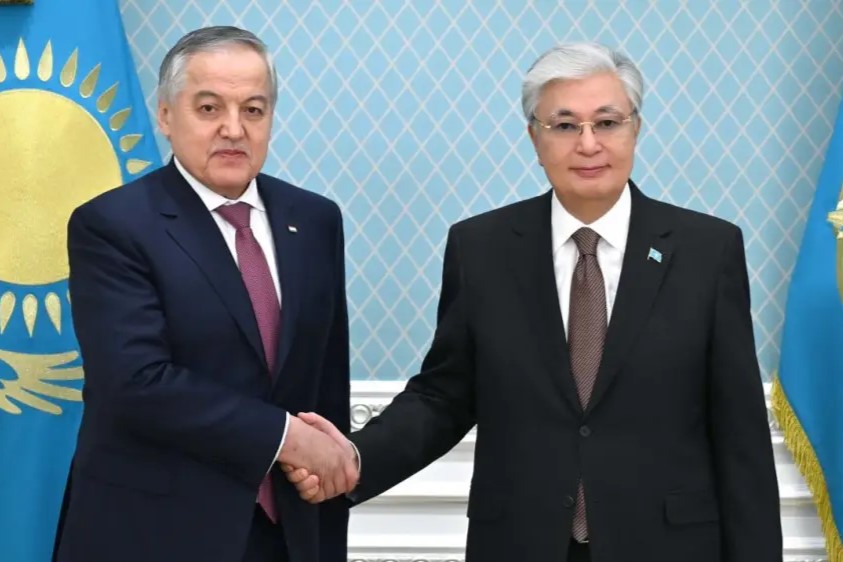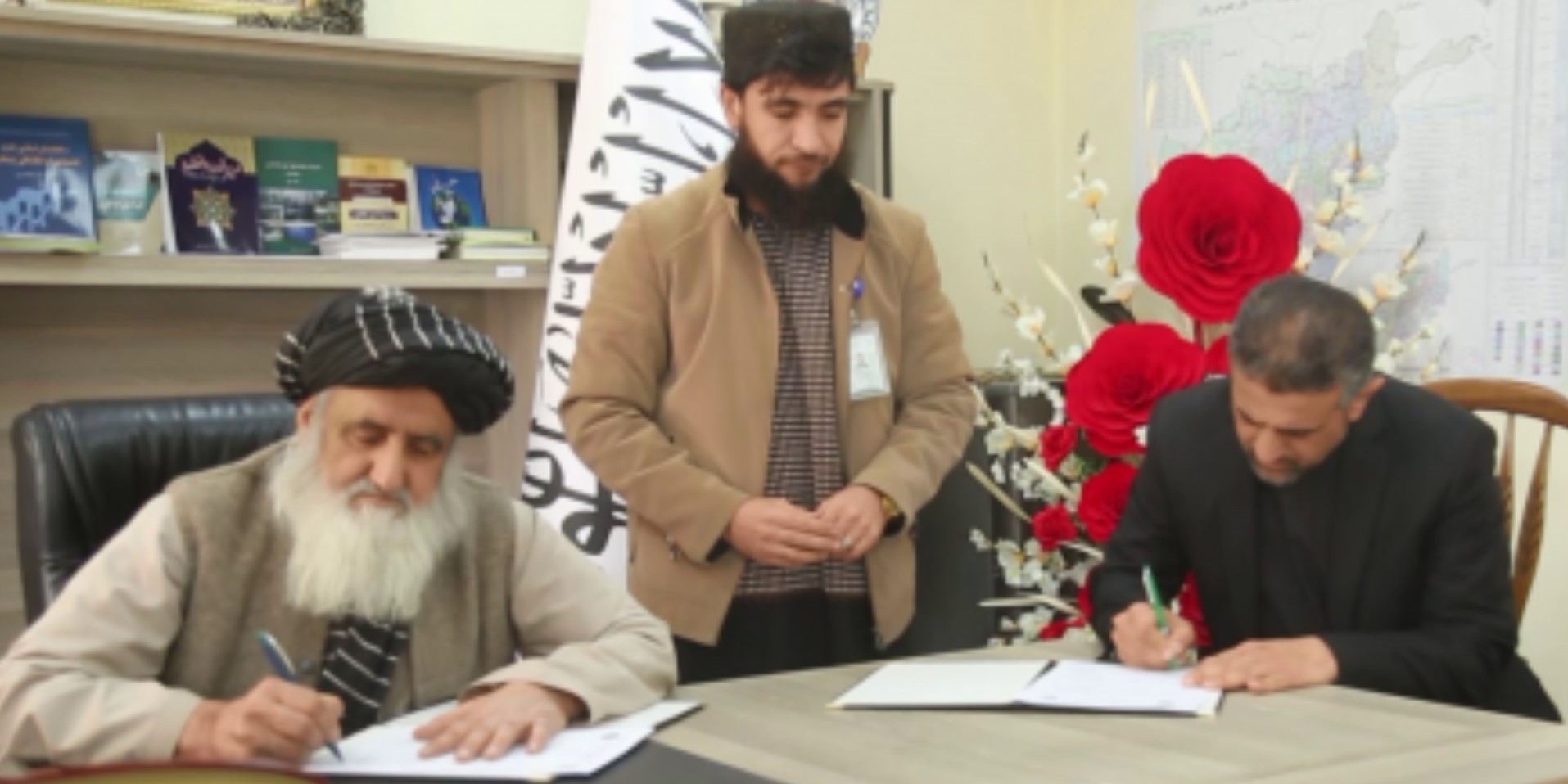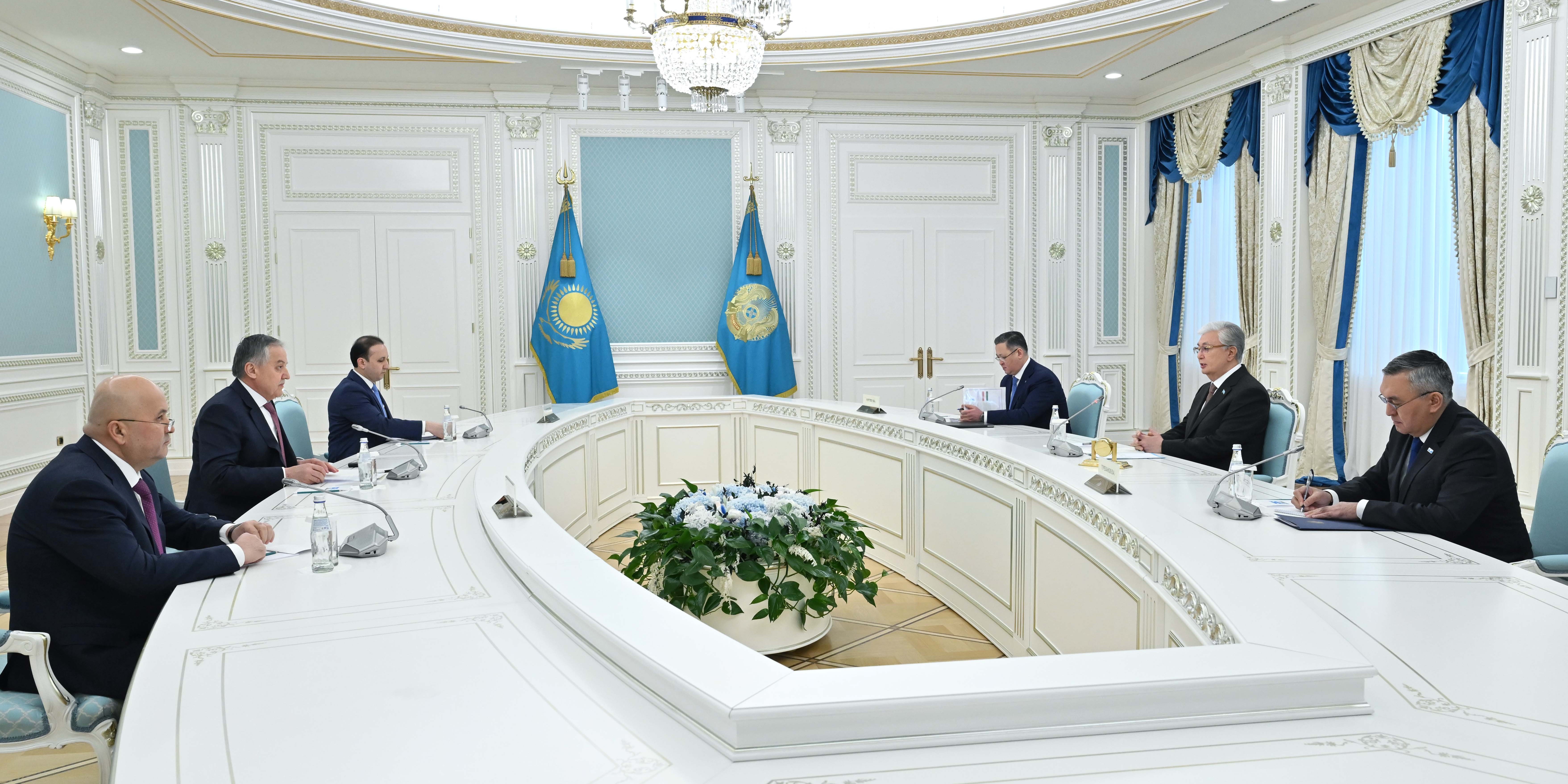This week, the media in the region covered several important energy stories, such as Türkiye and Turkmenistan's finalizing a deal that will see Turkmenistani gas exported to Türkiye through Iran and Uzbekistan’s plans to form an international consortium to develop its nuclear energy potential. They also reported on a number of trade developments, including Russia's lifting of restrictions on the transit of Kazakhstani agricultural products and Uzbekistani and Pakistani businessmen's negotiating of 181 deals valued at $500 million at the “Made in Uzbekistan” expo in Pakistan. Several outlets noted that Afghanistan concluded a $264 million contract to design a new railway from Herat to Kandahar, and the Canadian mining company, Ivanhoe Mines, began the exploration of a significant copper deposit in Kazakhstan. Lastly, multiple sources also covered the surge in remittances received by Kyrgyzstan.

Tajikistani Foreign Minister Sirojiddin Muhriddin met with President Tokayev and Foreign Minister Nurtleu in Astana. Source: Akorda
Energy
Türkiye and Turkmenistan have signed a deal to export Turkmenistani gas through Iran to Türkiye (Reuters). According to the Turkish Energy Minister Alparslan Bayraktar, the gas will begin flowing on March 1. Initially, Turkmenistan plans to export roughly 2 billion cubic meters annually. Currently, Türkiye consumes around 50 billion cubic meters of gas every year. Its leading suppliers include Russia, Iran, and Azerbaijan. The Turkish energy minister also confirmed that both countries are exploring the possibility of constructing a pipeline under the Caspian Sea to boost their energy cooperation further.
On February 10, Uzbekistani President Shavkat Mirziyoyev held a meeting to review the country’s nuclear industry (Kun). During the meeting, the President noted the growing energy needs of the population and the need to develop all energy resources. While 4 GW of electricity has been brought online, and the share of renewable energy has reached 16% in recent years, the government plans to add an additional 25 GW in the next five years to increase the share of renewables above 50% by 2030. Using the country’s significant uranium reserves, Uzbekistan plans to construct several small modular nuclear reactors. To this end, Azim Akhmedkhadjaev, the director of UzAtom, Uzbekistan’s nuclear energy agency, announced they would form an international consortium to support the development of nuclear projects, such as constructing a small modular NPP in Jizzakh (Kun). He outlined that they would utilise non-nuclear Chinese technologies, European software and hardware systems, and Russian systems. For instance, he mentioned that the project would employ various innovations, such as dry cooling towers from Chinese and Hungarian manufacturers, to minimise water consumption at the plant. Lastly, he also emphasised the importance of safety and that UzAtom has established a program with the International Atomic Energy Agency to train the necessary technicians.
According to Uzbekistan’s 2025 state program, the government expects to add more than 4.5 GW (up from 3.5 GW) of solar and wind energy in the next five years (Kun). In addition, photovoltaic panels with a capacity of 785 MW and HPPs with a capacity of 225 MW will be installed (up from 160 MW). The revised document excludes several initiatives, such as the plan to attract $10 million from the sale of carbon credits and several green development measures for tourist cities. Preferential tariffs for renewable energy will also be applied from April 1. These tariffs will also apply to biogas and waste incinerators. They also plan to introduce the practice of large state companies, such as Uzbekistan Airways and Uzneftegaz, conducting and publishing ESG reports. The document proposes the establishment of pilot industrial zones producing green products in Fergana and Samarkand. The minimum percentage of green components in investment projects will increase from 15% to 30% by 2027 and to 55% by 2030. The development of ecological master plans for districts and regions is proceeding, along with the introduction of environmental ratings for regions.
Kyrgyzstan’s ambassador in Saudi Arabia, Ulukbek Maripov, recently met with the Executive Director of Fas Renewable Energy, Marcus Schrauf (Kabar). They discussed the company’s plans to construct a 900 MW solar power plant for $500 million in collaboration with the Kyrgyzstani Green Energy Fund. They also explored the possibility of deepening cooperation in the energy sector.
Last week, Kyrgyzstan’s Minister of Energy, Taalaibek Ibrayev, held several meetings with the heads of multiple Chinese companies during a visit to China last week (AKIpress). He held talks with the Deputy Director General of China National Nuclear Corporation (CNNC) Zhang Kai. He emphasised the need to approve the planned 400 MW solar power plant in Issyk-Kyl. They also considered developing nuclear energy in Kyrgyzstan. He visited Beijing Capital International Airport and toured their new 25 MW solar power plant. He met with Sun Energy Co., which is building a 250 MW wind farm in the Batken region. During his visit, he also held discussions with representatives from companies contemplating investing in green energy in Kyrgyzstan, including Winday, Beyondsoft, Shongfuyan Group, Molin Energy Company, Covec China Overseas Engineering Group, and the China Machinery Engineering Corporation. He met with Li Bianchu, a member of the Board of Directors of TBEA, the company that expanded the Bishkek heating and power plant. He invited them to participate in modernizing the old units of the plant, laying a 110 kV cable line between Datka and Kemin, and developing the Jalalabad airport. Lastly, he met with Qian Liuyu, the main shareholder of the Kyrgyz-Chinese Joint Hydropower Construction Society, and revealed that it will construct a new small HPP in Kyrgyzstan (Kazinform). The new HPP will be built at the Papan reservoir on the Ak-Buura River in the Osh region. It will have a capacity of 25 MW and will cost around $27 million. The minister also indicated that the feasibility study was already complete.
Remittances
According to data from the National Bank of Kyrgyzstan, the gross inflow of remittances into the country surged to $2.99 billion in 2024 (24.kg). This represents a 10.5% increase compared to the 2023 figures. Russia accounted for 93.1% or $2.78 billion, with other significant amounts received from the U.S. (2.1% or $62.5 million) and South Korea (1.5% or $45.6 million). On the other hand, outflows decreased to $445.8 million, a 20.6% drop compared to 2023. Overall, net inflows rose by 18.6% to $2.55 billion (AKIpress).
Infrastructure
Afghanistan has signed contracts worth $264 million to design a new 737-kilometer railway between Kandahar and Herat (Daryo). This comes amid a broader effort to enhance Afghanistan’s infrastructure and regional connectivity. The project has garnered attention from Central Asian states that are interested in developing connections with Iran, Pakistan, and India. In 2024, Afghanistan, Kazakhstan, and Turkmenistan held talks on developing the corridor between Herat and Kandahar. Turkmenistan is also constructing a logistics centre at Torghundi on its border with Afghanistan. Meanwhile, Kazakhstan and Uzbekistan have agreed to cooperate to extend the country’s rail infrastructure and supply the necessary materials.

Afghanistan signed contracts valued at $264 million to design a railway between Herat and Kandahar. Source: Daryo
Finance
According to Uzbekistan’s Central Bank, the value of the country’s foreign currency and gold reserves amounted to $42.9 billion, an increase of $1.72 billion or 4.17% over January (Daryo). Notably, the country’s gold reserves rose by $3.02 billion to $35.06 billion. This significant growth has been driven by a surge in the price of gold on global markets, with a troy ounce reaching $2900. In terms of volume, Uzbekistan’s reserves only grew slightly from 12.3 million troy ounces (382.57 tons) to 12.6 million troy ounces (391.9 tons). At the same time, the country’s foreign exchange reserves fell by $1.29 billion to $7.3 billion. On the other hand, foreign securities rose to $102.1 million. Overall, the Central Bank’s holdings of foreign bonds have tripled since October, in accordance with its current investment policy.
Investment
In 2024, Tajikistan experienced a sharp increase in foreign capital inflows (The Caspian Post). The total inflow of foreign capital surged by 72% or $2.1 billion to $4.9 billion. 82.4% or $4.1 billion went to Dushanbe, 15.5% or $761.2 million to Sughd Province, 0.2% or $11.8 million to Khatlon Province, 0.1% or $3.2 million to districts of republican subordination, and 0.1% or $1.3 million to Gorno-Badakhshan Autonomous Oblast. Foreign direct investments (FDI) also rose by $110.2 million or 38.8% to $394.3 million. The lion’s share of FDI came from China ($150.9 million) and the U.S. ($118.9 million). Other significant investors include the U.K. ($51.1 million), Russia ($28.9 million), and Kazakhstan ($15.7 million).
The Asian Development Bank (ADB) will provide $222 million to finance key investment projects in Kyrgyzstan in 2025 (Kazinform). Of the $222 million, $74.8 million will be made up of grants, while the remaining $147.2 million will be preferential loans. They have pledged $40 million towards developing climate and disaster-resilient water management systems, $65 million to expand access to affordable and energy-efficient housing, and $50 million towards climate reforms under a policy-based loan. Under the Sustainable Energy Financing Facility (SEFF 2), they plan to give $3 million to renovate low-carbon municipal buildings, $1 million to a new business service center, and $530000 to build a floating solar power plant at the HPP 5 reservoir. Lastly, $37.5 million will be provided for the development of the Almaty-Bishkek economic corridor and $25 million for improving the energy efficiency of public buildings.
Diplomatic Events
On February 12, Tajikistani Foreign Minister Sirojiddin Muhriddin visited Astana (The Astana Times). He met with his Kazakhstani counterpart, Murat Nurtleu, to discuss the development of relations and the implementation of multiple agreements concluded during President Tokayev’s visit to Tajikistan last year. He also met with President Tokayev to consider expanding cooperation in various sectors, such as trade, agriculture, digitalization, and transit. They also explored enhancing energy cooperation during their deliberations. Following his meeting with Foreign Minister Nurtleu, Foreign Minister Muhriddin announced that Tajikistan and Kazakhstan would soon seek to sign an agreement on how much electricity Kazakhstan will receive from Tajikistan’s Rogun HPP (Kazinform).

Tajikistani Foreign Minister Sirojiddin Muhriddin met with President Tokayev and Foreign Minister Nurtleu in Astana. Source: Akorda
Trade
This week, Kazakhstani Minister of Agriculture Aidarbek Saparov announced that Rossekhoznadzor, Russia’s Federal Service for Veterinary and Phytosanitary Supervision, has lifted all transit restrictions on Kazakhstani vegetable and grains (Kazinform). According to the minister, he travelled to Moscow in January to meet with his Russian counterpart and the head of Rossekhoznadzor to consider the matter. While they resolved the issue in November, it took until January to fix all the logistical problems concerning transshipment. Nevertheless, restrictions on flowers remain in place, but the minister anticipated that this issue would likely be resolved within ten days. Last October, Russia restricted the import of specific Kazakhstani agricultural products due to phytosanitary concerns.
In 2024, Russia and Tajikistan conducted nearly 90% of their trade in roubles, according to Firdavs Tolibzoda, chairman of the National Bank of Tajikistan (Asia Plus). This represents a dramatic shift compared to 2021, when half of the trade between the two countries was conducted with the rouble. During the briefing, he also noted that Tajikistan was looking to minimise the risk of secondary sanctions by cooperating with Russian banks that are not subject to sanctions. Bilateral trade reached $1.98 billion in 2024, a 15.6% increase compared to 2023 (The Times of Central Asia). However, Russian imports account for 95.2% of trade, with Tajikistani exports to Russia only amounting to $95 million. While Russia remains Tajikistan’s largest trading partner, China is catching up. In 2024, Russia accounted for 22.1% of Tajikistan’s foreign trade turnover, whereas China accounted for 21.8%. Overall, trade with China grew by 30.1%, double the growth rate of trade with Russia.
Uzbekistani and Pakistani businesses concluded 181 deals worth $500 million at the “Made in Uzbekistan” expo in Lahore (Kursiv). Overall, they concluded deals for $263 million worth of Uzbekistani exports and $236 million of imports. Discussions also took place about establishing Uzbekistan trade houses in Pakistan and enhancing cooperation in the textile, pharmaceutical, and transport sectors. Both countries also agreed to expand the list of goods covered by their preferential trade agreement, simplify the process for exporting horticultural products, and create a working group to promote their goods on online trading platforms.
On February 11, the Joint Uzbekistani-Mongolian Commission on International Road Transport met in Tashkent (UZ Daily). Representatives of both countries discussed developing freight transportation and improving road transport between Uzbekistan and Mongolia. They agreed to double the number of cargo transport permits for 2025 and introduce an electronic permit exchange system.
Mining
The Canadian company Ivanhoe Mines, one of the world’s leading copper mining companies, has begun exploring the Chu-Sarysu Basin in Kazakhstan (Kursiv). In collaboration with Pallas Resources from the U.K., they will survey around 16000 square kilometres of land. Overall, the company has allocated $18.7 million for the venture. The U.S. Geological Survey estimates that the Chu-Sarysu Basin could contain 25 million tons of copper.
Border Issues
At a press briefing, Tajikistan’s Foreign Minister, Sirojiddin Muhriddin, noted that while the border between Tajikistan and Kyrgyzstan has been fully delineated, water facilities and road access remain under discussion (Asia Plus). He underlined that the border has been demarcated, and only the official documentation needs to be drafted and signed. Nevertheless, he remarked that the working groups still regularly discuss two outstanding issues. These include the construction of a road between the Tajikistani exclave of Vorukh and the city of Isfara in Tajikistan, as well as the ownership and operation of several water facilities. While he did not identify the discussed water facilities, it is assumed they include the Golovnaya water distribution facility, the Dousti canal, and several other irrigation canals. Water facilities and road access were two principal triggers for the violence that erupted in April 2021 and September 2022. In addition to the broader border agreement, he stated that two separate treaties on road and water facilities would be drafted but did not specify when they would be signed.
Migration
Recent reports show that interest in relocating to Russia continues to decline (Asia Plus). In 2024, only 28400 people moved to Russia under the State Program for the Resettlement of Compatriots, the lowest figure in recent years. The sharpest decline was in Tajikistan. Between 2021 and 2023, around 10000 Tajikistanis resettled in Russia annually. However, in 2024, this number fell to 5244. Other countries also experienced similar declines. The number of Armenians relocating to Russia dropped from 5,866 in 2023 to 2,129 in 2024, while the number of Moldovans fell from 1,105 in 2023 to 567 in 2024. This comes despite renewed efforts to facilitate resettlement and immigration, such as removing the requirement to prove Russian language proficiency and a new law that enables repatriates to receive permanent residence permits immediately instead of first applying for a temporary permit. Nevertheless, numbers have continued to fall, likely the result of increased xenophobia and official actions against illegal migrants following the Crocus City Hall terrorist attack in 2024.

